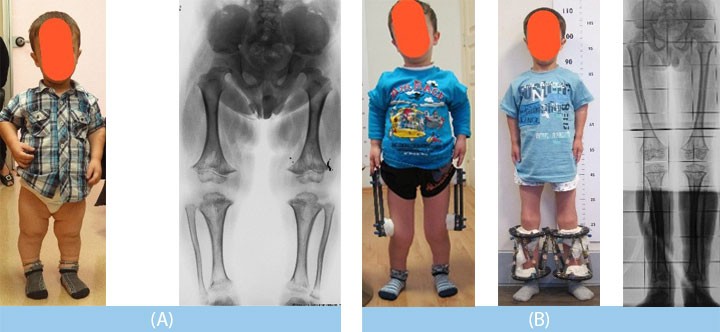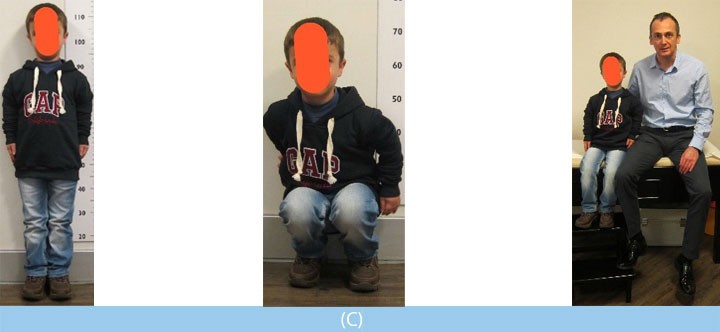What is achondroplasia (dwarfism) and how is it treated?
What is achondroplasia (dwarfism)?
Achondroplasia and hypochondroplasia are hereditary conditions that make up 80% of the cases of dwarfism. Hypochondroplasia is a mild form of achondroplasia. It is caused by an abnormality in the FGFR3 gene. It can be easily diagnosed by genetic specialists through blood tests or in the womb. The height appears normal at the time of birth. As the child grows, however, they begin to fall under in height compared to their peers and abnormalities in the skeletal system become apparent. Endochondral ossification affects the pattern of ossification that allows the growth of long bones such as the arms and legs. Endochondral ossification is a disorder that affects the middle section of the growth plates in particular. Therefore, the growing bones (humerus, tibia) are the most affected. The head and trunk of the body are normal. The pelvic bone, skull and other bones show normal development. Length discrepancies in the arms and legs as well as bone discrepancies in the extremities of the limbs close to the body, disproportionate lengths as well as "rhizomelic micromelia" occur in this situation. Men reach a maximum height of 131 cm, while women reach a maximum height of 124 cm. The forehead, cheekbones and jawbone may be smaller. The hands are short and wide, and the middle finger is shorter than normal. There is often a "bowleg". The elbow joint does not fully straighten (flexion contracture). The intelligence of the personal is normal, but obesity is a major problem in many patients. Depending on the way the bones in the spine develop, back problems can develop in the 20s.
What is achondroplasia (dwarfism) and how is it treated?
The goal of treatment is to correct the deformities and perform lengthening in the lower half of the body in order to give the patient a normal height. The arms are lengthened and corrected in a separate session.
First correction, ages 5-7
The next 1-2 years after age 5 are very important. In this period, bones have a very good potential to heal. The maximum lengthening can be achieved during this period. The lengthening procedures are performed with an external fixator. The first session consists of two surgeries. Either both femurs or both tibia are lengthened, depending on the patient's condition. During these 2 sessions, a lengthening of 20-25 cm is achieved. Bone deformities should also be corrected at the same time, and the bones should be brought to the desired proportion. The second session is done at the ages of 10-11. At this stage, a lengthening of about 14 cm of the femur can be achieved in 2 stages with the use of magnetic lengthening rods. The third session takes place at ages 14-16. At this stage, both tibiae are extended by 5-7 cm and the femur and tibia are made proportionate. Also, arm lengthening surgery is performed for patients in this age group.
An Important Note
An important note about lengthening for children with achondroplasia: In children with achondroplastia, 2 bones on the same side (upper thigh and lower tibia) should not be lengthened. Although treatment like this was done in the past, many doctors have given it up due to objections being raised about it. It is believed that the natural growth potential of the child would be suppressed or inhibited because performing a lengthening on the same side suppresses the growth plate.
An important point about lengthening procedures done for children: The rate of complication is very high in lengthening surgery performed before the age of 5 (growth plate suppression, infection, new curvatures appearing during the lengthening, etc.). For the first lengthening surgery, the child should have reached the age of 5.


A) The short stature of the patient had been caused by achondroplasia. If left untreated, it was calculated that the patient would reach a maximum height of 90 cm by the time of adulthood.
B) The treatment for the achondroplasia was begun at the age of 5, the ideal age of a first lengthening, and both femurs were lengthened by 12 cm. A year later at the age of 6.5, the tibiae were lengthened 11 cm.
C) In this way, by the time the patient reached the age of 7, a total lengthening of 23 cm had been done.
Leg Length Discrepancy
and Limb Deformities
in Children
Leg Length Discrepancy
and Limb Deformities
in Adults?
Nonunions
and
Osteomyelitis
Achondroplasia
(Nanism)
Cosmetic
Leg Lengthening
How are length
discrepancies in the
toes and arms treated?
Length Extension
Techniques
- Lengthening Nails
- External Fixators
- Combined techniques
